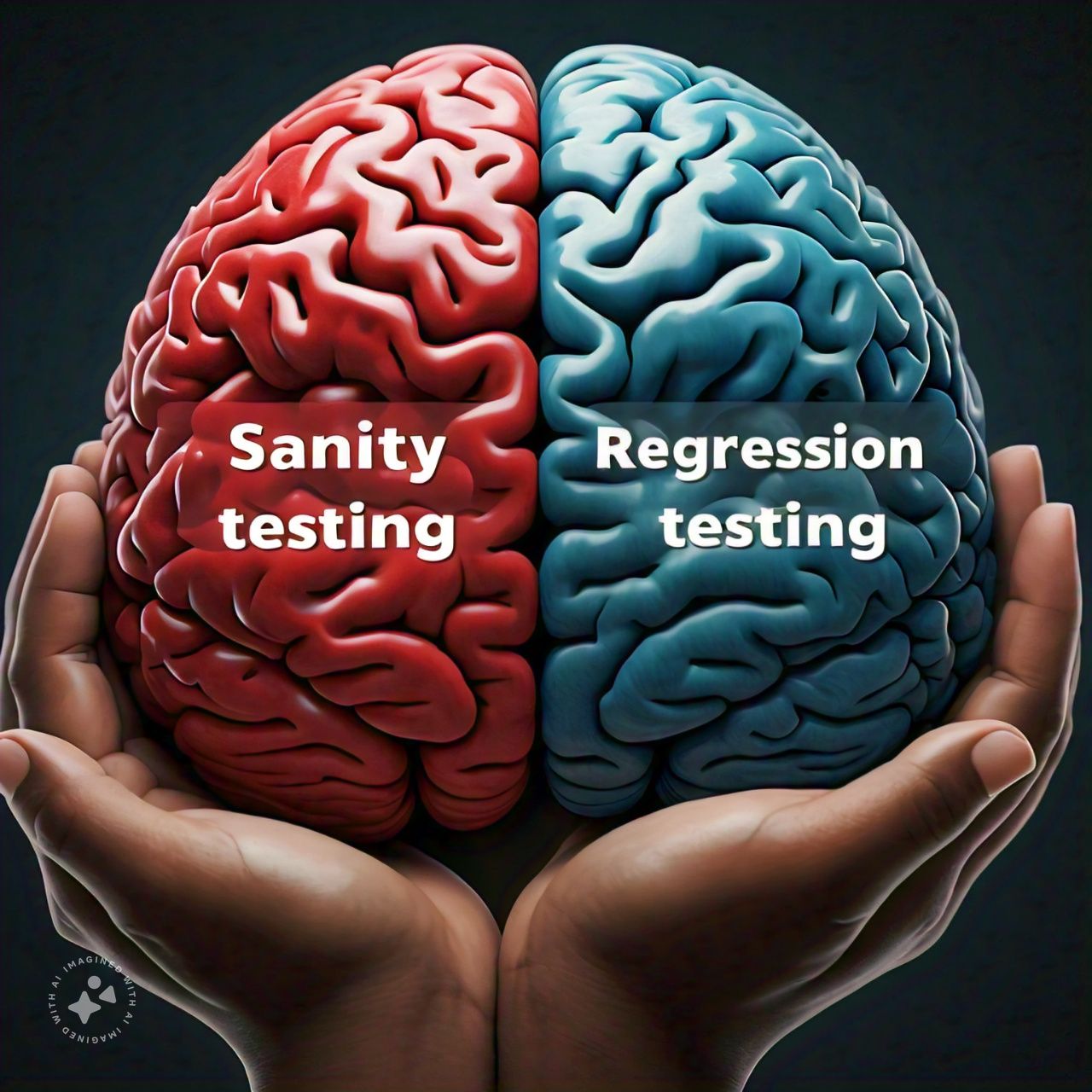 By: John Abhilash / July 26, 2024
By: John Abhilash / July 26, 2024
In the ever-evolving landscape of software development, maintaining quality assurance is crucial. Two key testing methodologies that play a significant role in this process are sanity testing and regression testing. While both aim to ensure software functionality, they serve different purposes and are used at various stages of the development lifecycle. This blog post explores the nuances of sanity testing vs regression testing, highlighting their differences, applications, and importance in modern software development.
Sanity testing, often confused with smoke testing, is a specific type of regression testing focused on verifying the basic functionality of a software application after minor changes or bug fixes. The main objective of sanity testing is to determine whether it makes sense to proceed with more thorough testing efforts.
Key aspects of sanity testing include:
Quick and Focused: Sanity testing is designed to be swift and targeted, usually covering only the core functionalities of the software.
Surface-Level Verification: It aims to ensure that the most critical features are functioning as expected without diving into intricate details.
Time-Efficient: This type of testing is often performed to save time and resources by quickly identifying major issues before moving on to more extensive testing.
Build Acceptance: It helps determine if a build is stable enough for further testing or if it should be rejected.
Sanity testing is especially useful in agile development environments where frequent builds and rapid iterations are common. By conducting sanity tests, teams can quickly check if new changes have introduced any obvious defects or if the core functionality remains intact.
Regression testing, on the other hand, is a more comprehensive approach that aims to ensure that recent changes or additions to the software haven’t adversely affected existing functionality. It involves re-running previously executed test cases to verify that the system still behaves as expected after modifications.
Key aspects of regression testing include:
Broad Scope: Regression testing covers a wide range of functionalities, including both new and existing features.
In-Depth Verification: It involves thorough testing of all aspects of the software to identify any unintended side effects or regressions.
Time-Intensive: Regression testing is generally more time-consuming than sanity testing due to its comprehensive nature.
Continuous Quality Assurance: It helps maintain software quality throughout the development lifecycle by catching regressions early.
Regression testing is crucial for maintaining the stability and reliability of software applications, especially in complex systems where changes in one area may have unforeseen consequences in others.
Now that we have a basic understanding of both testing approaches, let’s explore the key differences between sanity testing vs regression testing:
Aspect | Sanity Testing | Regression Testing |
Scope | Narrow focus on core functionalities | Comprehensive coverage of all software features |
Depth | Surface-level verification of basic functionality | In-depth testing of all aspects, including edge cases |
Time and Resources | Quick and resource-efficient | Time-consuming and resource-intensive |
Objective | Determine if further testing is warranted | Ensure existing functionality remains intact after changes |
Frequency | Performed after minor changes or bug fixes | Conducted after significant changes or periodically |
Test Case Selection | Limited set of test cases focusing on core features | Comprehensive set of test cases covering all aspects |
Automation | Often performed manually due to its quick nature | Frequently automated to handle large test suites efficiently |
Choosing between sanity testing and regression testing depends on various factors, including the project stage, the nature of changes, and available resources. Here are some guidelines for when to use each approach:
Use Sanity Testing When:
Making minor changes or bug fixes
Time is limited, and a quick assessment is needed
Determining if a build is stable enough for further testing
Verifying basic functionality after configuration changes
Use Regression Testing When:
Implementing significant new features or major changes
Preparing for a release or milestone
Ensuring overall system stability and reliability
Identifying unintended side effects of changes in complex systems
To maximize the effectiveness of sanity testing, consider the following best practices:
Prioritize Critical Functionalities: Focus on the most important features that are essential for the software’s core operation.
Maintain a Concise Test Suite: Keep the sanity test cases limited to ensure quick execution.
Update Regularly: Revise the sanity test suite as the software evolves to ensure it remains relevant.
Automate When Possible: While often performed manually, automating sanity tests can further improve efficiency.
Document Results: Keep track of sanity test outcomes to identify patterns or recurring issues.
To ensure effective regression testing, consider these best practices:
Maintain a Comprehensive Test Suite: Include test cases that cover all aspects of the software, including edge cases and various configurations.
Prioritize Test Cases: Use risk-based approaches to prioritize critical test cases when time is limited.
Implement Test Automation: Automate regression tests to handle large test suites efficiently and reduce human error.
Use Version Control: Keep test scripts and test data under version control to track changes and maintain consistency.
Perform Regular Test Suite Maintenance: Review and update test cases to remove obsolete ones and add new ones as needed.
Utilize Parallel Execution: Leverage parallel testing techniques to reduce execution time for large regression test suites.
Implement Continuous Integration: Integrate regression testing into the CI/CD pipeline for early detection of issues.
Both sanity testing and regression testing come with their own set of challenges:
Challenges in Sanity Testing:
Determining the Right Scope: Balancing between too narrow and too broad coverage
Avoiding False Positives: Ensuring that passing sanity tests truly indicate software stability
Maintaining Relevance: Keeping sanity test suites up-to-date with evolving software
Challenges in Regression Testing:
Test Suite Maintenance: Managing and updating large sets of test cases
Execution Time: Dealing with long execution times for comprehensive test suites
Test Data Management: Maintaining and versioning test data for various scenarios
Identifying Root Causes: Pinpointing the exact cause of regressions in complex systems
While sanity testing is often performed manually, various tools can assist in both sanity and regression testing efforts:
Selenium: Popular for web application testing, suitable for both sanity and regression testing
JUnit: Unit testing framework for Java, useful for creating and running test suites
TestNG: Testing framework for Java with advanced features for test organization and parallel execution
Jenkins: CI/CD tool that can be integrated with various testing frameworks for automated testing
JIRA: Issue tracking system that can be used to manage test cases and results
Cucumber: Behavior-driven development tool that can be used for creating readable test scenarios
In agile development methodologies, both sanity testing and regression testing play crucial roles:
Sanity Testing in Agile:
Quickly validates new builds before sprint demos
Ensures basic functionality after each iteration
Supports rapid feedback loops in continuous integration
Regression Testing in Agile:
Maintains overall system stability throughout sprints
Verifies that new features don’t break existing functionality
Supports continuous delivery by ensuring quality at each release
As software development practices continue to evolve, we can expect several trends to impact sanity testing and regression testing:
AI-Powered Test Case Generation: Machine learning algorithms to create and optimize test cases
Shift-Left Testing: Moving testing earlier in the development process, blurring the lines between development and testing
Containerization: Using containerized environments for consistent and reproducible testing
Visual Regression Testing: Automated comparison of UI changes to detect unintended visual regressions
Performance Regression Testing: Increased focus on identifying performance degradations alongside functional regressions
Sanity testing and regression testing are both essential components of a robust software quality assurance strategy. While sanity testing provides a quick assessment of basic functionality, regression testing ensures comprehensive coverage and long-term stability. By understanding the differences between these approaches and applying them appropriately, development teams can maintain high-quality software products throughout the development lifecycle.
As the software industry continues to evolve, the importance of effective testing methodologies will only grow. By mastering the art of sanity testing versus regression testing, organizations can stay ahead of the curve and deliver reliable, high-quality software to their users.
Check Out Other Resources : Master ASPM :Build a secure strategy ,Sanity Testing, Regression Testing







Leave a Comment